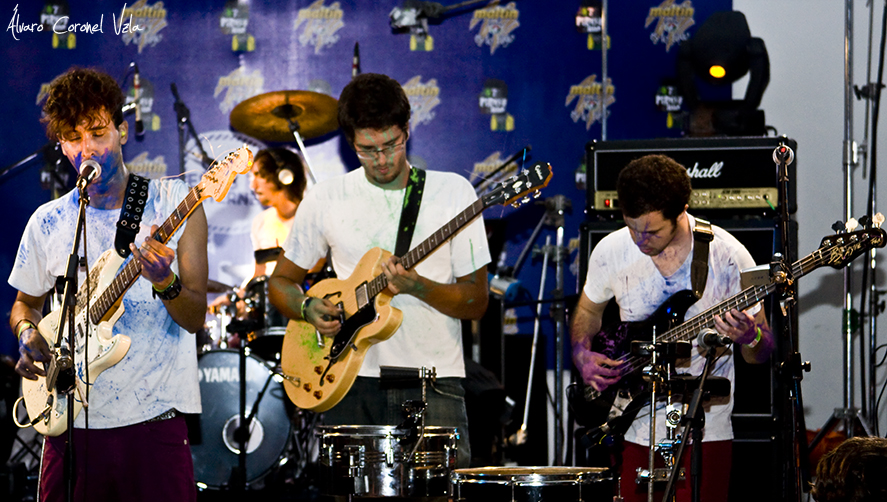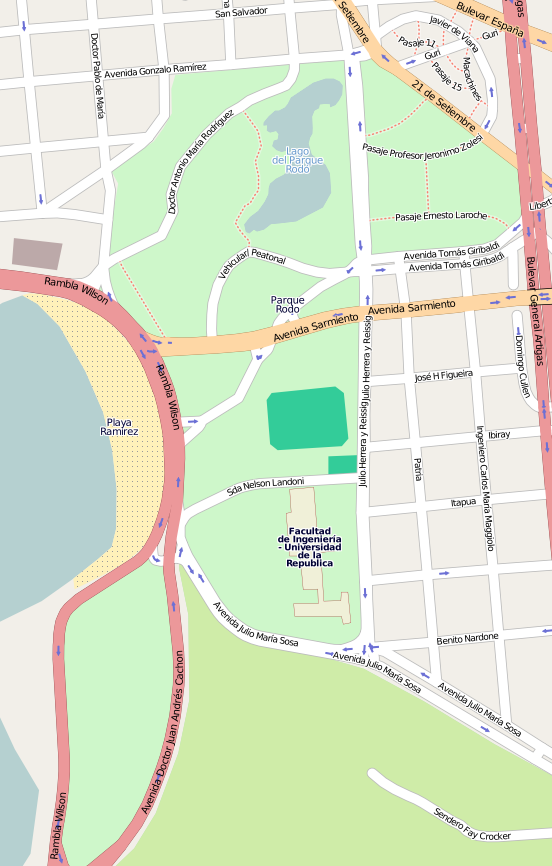|
Palermo, Montevideo
Palermo is a ''barrio'' (neighbourhood or district) of Montevideo, Uruguay. Location Palermo shares borders with Barrio Sur to the west, Cordón to the north and Parque Rodó to the east, while to the south it borders the coastline, with Rambla República de Argentina running along it. Landmarks It is home to the Arts and Trades School, ALADI and the Edificio Mercosur, seat of the parliament of the Mercosur member countries. Places of worship * Church and convent of St. Anthony and St. Clare (Roman Catholic, Friars Minor Capuchin) * Parish Church of Our Lady of the Orchard and St. Joseph (Roman Catholic) See also *Barrios of Montevideo The city of Montevideo, capital of Uruguay, is divided into 62 ''barrios'' (neighborhoods or districts), each with its own identity, demographic characteristics and activities appropriate to the socio-cultural level of its inhabitants. The outer ... External links Intendencia de Montevideo / Historia del Sur y Palermo Notes ... [...More Info...] [...Related Items...] OR: [Wikipedia] [Google] [Baidu] |
Barrio
''Barrio'' () is a Spanish language, Spanish word that means "Quarter (urban subdivision), quarter" or "neighborhood". In the modern Spanish language, it is generally defined as each area of a city, usually delimited by functional (e.g. residential, commercial, industrial, etc.), social, architectural or morphological features. In Spain, several Latin America, Latin American countries and the Philippines, the term may also be used to officially denote a division of a municipality. ''Barrio'' is an arabism (Classical Arabic ''barrī'': "wild" via Andalusian Arabic ''bárri'': "exterior"). Usage In Argentina and Uruguay, a ''barrio'' is a division of a municipality officially delineated by the local authority at a later time, and it sometimes keeps a distinct character from other areas (as in the Barrios and Communes of Buenos Aires, barrios of Buenos Aires even if they have been superseded by larger administrative divisions). The word does not have a special socioeconomic connotat ... [...More Info...] [...Related Items...] OR: [Wikipedia] [Google] [Baidu] |
Rambla Of Montevideo
The Rambla of Montevideo is an avenue (landscape), avenue that goes all along the coastline of Montevideo, Uruguay. At a length of over 22.2 uninterrupted kilometres (13.7 mi), the promenade runs along the Río de la Plata and continues down the entire coast of Montevideo. Since all the southern departments of Uruguay are against either the Río de la Plata or the Atlantic Ocean, they all have ramblas as well. The Rambla is an integral part of Montevidean identity and has been proposed as a List of World Heritage Sites in the Americas, World Heritage site. ''La Rambla'', South of the Bay of Montevideo, is an environment for a wide variety of outdoor activities such as jogging, walking, biking, fishing, kite-flying, sunbathing and drinking Mate (drink), mate. Skateboarding and roller skating are also possible in special areas for these activities. The avenue is secured by the Tourism Police Unit during the summer to keep a safe environment for tourists. The beach is state-o ... [...More Info...] [...Related Items...] OR: [Wikipedia] [Google] [Baidu] |
Barrios Of Montevideo
The city of Montevideo, capital of Uruguay, is divided into 62 ''barrios'' (neighborhoods or districts), each with its own identity, demographic characteristics and activities appropriate to the socio-cultural level of its inhabitants. The outer barrios of Montevideo are largely rural. In a more general usage of the word ''barrio'', some people refer to the biggest large-scale residential complexes of Montevideo as barrios, although they do not appear as such in official lists. Such are the Parque Posadas in Aires Puros, the Euskal Erría complexes in Malvin Norte and others. Many areas of the city that are now considered barrios had geographically independent populations that were later absorbed into the growing city. This is the case with Sayago, Pocitos, Carrasco and others. Some barrios grew out of industrial areas, such as Cerro and Nuevo París. Other areas that were considered distinct barrios have been subsumed into larger barrios. Such is the barrio Goes, most of w ... [...More Info...] [...Related Items...] OR: [Wikipedia] [Google] [Baidu] |
Nuestra Señora Del Huerto Y San José, Montevideo
''Nuestra'' is the debut studio album of the Venezuelan rock band La Vida Bohème, released in August 2010. Recorded and produced by Rudy Pagliuca, it is a free download on the website of the record label All of the Above. The album was nominated for "Best Latin Pop, Rock or Urban Album" in the 54th Grammy Awards. The two singles from this album are "Radio Capital" and "Danz!". Background and Recording The album was recorded in Caracas in 2009, on fairly independent terms. Guitarist Daniel De Sousa happened to be studying engineering at the time, and took on designing a distortion pedal that was used on the album. The synths were designed/programmed by fellow Venezuelan artist Arca, then known as Nuuro. In popular culture The song "El Buen Salvaje" is included in the video game ''FIFA 12'', winning the MTV Game Awards 2012 for "Best song in a video game". "Radio Capital" is present in the Rockstar's video game ''Grand Theft Auto V ''Grand Theft Auto V'' is a 2013 ac ... [...More Info...] [...Related Items...] OR: [Wikipedia] [Google] [Baidu] |
Friars Minor Capuchin
The Order of Friars Minor Capuchin (; Post-nominal letters, postnominal abbr. O.F.M. Cap.) is a religious order of Franciscans, Franciscan friars within the Catholic Church, one of Three "Religious institute#Nomenclature, First Orders" that reformed from the Order of Friars Minor, Franciscan Friars Minor Observant (OFM Obs., now OFM), the other being the Order of Friars Minor Conventual, Conventuals (OFM Conv.). Franciscans reformed as Capuchins in 1525 with the purpose of regaining the original Habit (Tunic) of St. Francis of Assisi and also for returning to a stricter observance of the rule established by Francis of Assisi in 1209. History Origins The Order arose in 1525 when Matteo da Bascio, an Order of Friars Minor, Observant Franciscan friar native to the Italian region of Marche, said he had been inspired by God with the idea that the manner of life led by the friars of his day was not the one which their founder, St. Francis of Assisi, had envisaged. He sought to retu ... [...More Info...] [...Related Items...] OR: [Wikipedia] [Google] [Baidu] |
San Antonio Y Santa Clara, Montevideo
The Church of Saint Anthony and Saint Clare ( es, Iglesia de San Antonio y Santa Clara) is a Roman Catholic parish church in Montevideo, Uruguay. Overview This church is part of an important architectural ensemble which includes a convent; it is located on the intersection of the streets Canelones and Minas, in the barrio Palermo. The parish was established on 7 September 1961. Held by the Friars Minor Capuchin, who have a long history in the territory of Uruguay since colonial times and now conform a Province with Argentina. The church is dedicated to Saint Anthony of Padua and Saint Clare of Assisi. It boasts a Tamburini organ from 1924, one of the biggest in the country. Same devotion There are other churches in Uruguay dedicated to |
ALADI
The Latin American Integration Association / Asociación Latinoamericana de Integración / Associação Latino-Americana de Integração (LAIA / ALADI) is an international and regional scope organization. It was created on 12 August 1980 by the 1980 Montevideo Treaty, replacing the Latin American Free Trade Association (LAFTA/ALALC). Currently, it has 13 member countries, and any of the Latin American States may apply for accession. Objectives The development of the integration process developed within the framework of the ALADI aims at promoting the harmonious and balanced socio-economic development of the region, and its long-term objective is the gradual and progressive establishment of a Latin-A ...[...More Info...] [...Related Items...] OR: [Wikipedia] [Google] [Baidu] |
Parque Rodó
Parque Rodó is both a ''barrio'' (neighbourhood or district) of Montevideo, Uruguay and a park which lies mostly outside the limits of the barrio itself and belongs to Punta Carretas. The name "Rodó" has been given in memory of José Enrique Rodó, an important Uruguayan writer whose monument is in the southern side of the main park. The park On the north side of the main park is an artificial lake with a little castle housing a municipal library for children. An area to its west is used as an open-air exhibition of photography. Apart from the main park area which is delimited by Sarmiento Avenue to the south, Parque Rodó includes an amusement park, the Estadio Luis Franzini, belonging to Defensor Sporting, the front lawn of the Faculty of Engineering, and a stripe West of the Club de Golf del Uruguay which includes the ''Canteras del Parque Rodó'' (the quarry of), the ''Teatro de Verano'' and the ''Lago del Parque Rodó'' (the lake of). The barrio Parque Rodó ''barrio'' sha ... [...More Info...] [...Related Items...] OR: [Wikipedia] [Google] [Baidu] |
List Of Sovereign States
The following is a list providing an overview of sovereign states around the world with information on their status and recognition of their sovereignty. The 206 listed states can be divided into three categories based on membership within the United Nations System: 193 UN member states, 2 UN General Assembly non-member observer states, and 11 other states. The ''sovereignty dispute'' column indicates states having undisputed sovereignty (188 states, of which there are 187 UN member states and 1 UN General Assembly non-member observer state), states having disputed sovereignty (16 states, of which there are 6 UN member states, 1 UN General Assembly non-member observer state, and 9 de facto states), and states having a special political status (2 states, both in free association with New Zealand). Compiling a list such as this can be a complicated and controversial process, as there is no definition that is binding on all the members of the community of nations concerni ... [...More Info...] [...Related Items...] OR: [Wikipedia] [Google] [Baidu] |
Cordón
Cordón is a central ''barrio'' (neighbourhood or district) of Montevideo, Uruguay, located East of the Centro. Its main avenue is 18 de Julio Avenue. History Cordón was the first neighborhood to be created outside the walls of the old Citadel of Montevideo. In its origins it was known as "''El Cardal''", due to the fact that thistles () grew in the fields dedicated to the cultivation of corn. It was a large vacant lot that extended to the other side of the wall, behind the "''Ejidos''", that is, after the area of open land that was used for the defense of the Citadel. In 1765 the Spanish Crown ordered Bartolomé Mitre Martínez to delineate approximately 60 blocks for population. The area to the east of the demarcation was called "''Cordón''", from which the name of the neighborhood comes, because the land marking work was carried out using laces (). In January 1807 the entire area was the scene of the Battle of Cardal in the framework of the second British invasion of the ... [...More Info...] [...Related Items...] OR: [Wikipedia] [Google] [Baidu] |
Barrio Sur, Montevideo
Barrio Sur is a ''barrio'' (neighbourhood or district) of Montevideo, Uruguay. Location Barrio Sur is directly south of the Centro and is delimited by Canelones Str. on the North, Andes Str. on the West, the coastal avenue (the "Rambla") on the South and Dr Barrios Amorin Str. on the East. It is home to the Central Cemetery of Montevideo. History The history of Barrio Sur started around 1835 with the foundation of the cemetery. With the end of slavery in Uruguay, it became predominantly inhabited by Afro-Uruguayans. The first generation of liberated slaves started reviving some of the rituals of their countries of origin, which became known as Tangos or Tambos. From these rituals was born the Candombe. On 6 January, they held the ritual parade called "Llamad de los reyes" which honoured to the eldest members of the community. Later generations of Afro-Uruguayans gave up these rituals and focused rather on becoming integrated with the rest of the society of Montevideo. In more rece ... [...More Info...] [...Related Items...] OR: [Wikipedia] [Google] [Baidu] |
.jpg)






